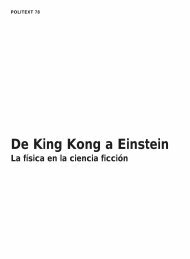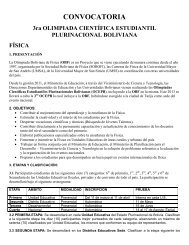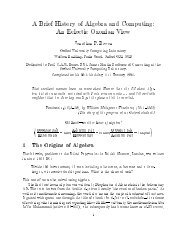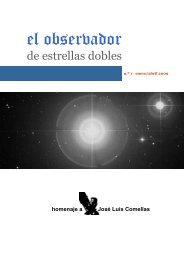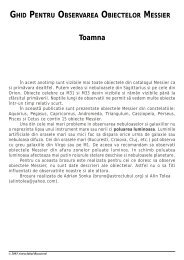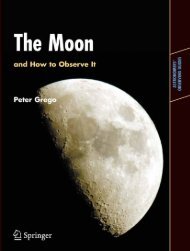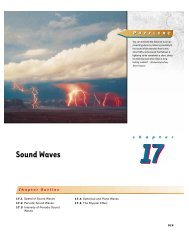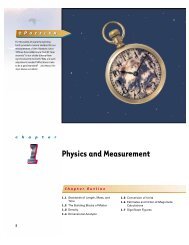Circular Motion and Other Applications of Newton's Laws
Circular Motion and Other Applications of Newton's Laws
Circular Motion and Other Applications of Newton's Laws
You also want an ePaper? Increase the reach of your titles
YUMPU automatically turns print PDFs into web optimized ePapers that Google loves.
cients <strong>of</strong> friction between block <strong>and</strong> disk are 0.750 (static)<br />
<strong>and</strong> 0.640 (kinetic) while those for the penny <strong>and</strong><br />
block are 0.450 (kinetic) <strong>and</strong> 0.520 (static), what is the<br />
maximum rate <strong>of</strong> rotation (in revolutions per minute)<br />
that the disk can have before either the block or the<br />
penny starts to slip?<br />
59. Figure P6.59 shows a Ferris wheel that rotates four times<br />
each minute <strong>and</strong> has a diameter <strong>of</strong> 18.0 m. (a) What is<br />
the centripetal acceleration <strong>of</strong> a rider? What force does<br />
the seat exert on a 40.0-kg rider (b) at the lowest point<br />
<strong>of</strong> the ride <strong>and</strong> (c) at the highest point <strong>of</strong> the ride?<br />
(d) What force (magnitude <strong>and</strong> direction) does the seat<br />
exert on a rider when the rider is halfway between top<br />
<strong>and</strong> bottom?<br />
Figure P6.59 (Color Box/FPG)<br />
2.50 m<br />
Problems 179<br />
θ<br />
8.00 m<br />
Figure P6.61<br />
63. An amusement park ride consists <strong>of</strong> a large vertical<br />
cylinder that spins about its axis fast enough that any<br />
person inside is held up against the wall when the floor<br />
drops away (Fig. P6.63). The coefficient <strong>of</strong> static friction<br />
between person <strong>and</strong> wall is � s, <strong>and</strong> the radius <strong>of</strong><br />
the cylinder is R. (a) Show that the maximum period <strong>of</strong><br />
revolution necessary to keep the person from falling is<br />
T � (4� 2 R� s/g) 1/2 . (b) Obtain a numerical value for T<br />
60. A space station, in the form <strong>of</strong> a large wheel 120 m in<br />
diameter, rotates to provide an “artificial gravity” <strong>of</strong><br />
3.00 m/s 2 for persons situated at the outer rim. Find<br />
the rotational frequency <strong>of</strong> the wheel (in revolutions<br />
per minute) that will produce this effect.<br />
61. An amusement park ride consists <strong>of</strong> a rotating circular<br />
platform 8.00 m in diameter from which 10.0-kg seats<br />
are suspended at the end <strong>of</strong> 2.50-m massless chains<br />
(Fig. P6.61). When the system rotates, the chains make<br />
an angle � � 28.0° with the vertical. (a) What is the<br />
speed <strong>of</strong> each seat? (b) Draw a free-body diagram <strong>of</strong> a<br />
40.0-kg child riding in a seat <strong>and</strong> find the tension in the<br />
chain.<br />
62. A piece <strong>of</strong> putty is initially located at point A on the rim<br />
<strong>of</strong> a grinding wheel rotating about a horizontal axis.<br />
The putty is dislodged from point A when the diameter<br />
through A is horizontal. The putty then rises vertically<br />
<strong>and</strong> returns to A the instant the wheel completes one<br />
revolution. (a) Find the speed <strong>of</strong> a point on the rim <strong>of</strong><br />
the wheel in terms <strong>of</strong> the acceleration due to gravity<br />
<strong>and</strong> the radius R <strong>of</strong> the wheel. (b) If the mass <strong>of</strong> the<br />
putty is m, what is the magnitude <strong>of</strong> the force that held<br />
it to the wheel? Figure P6.63



